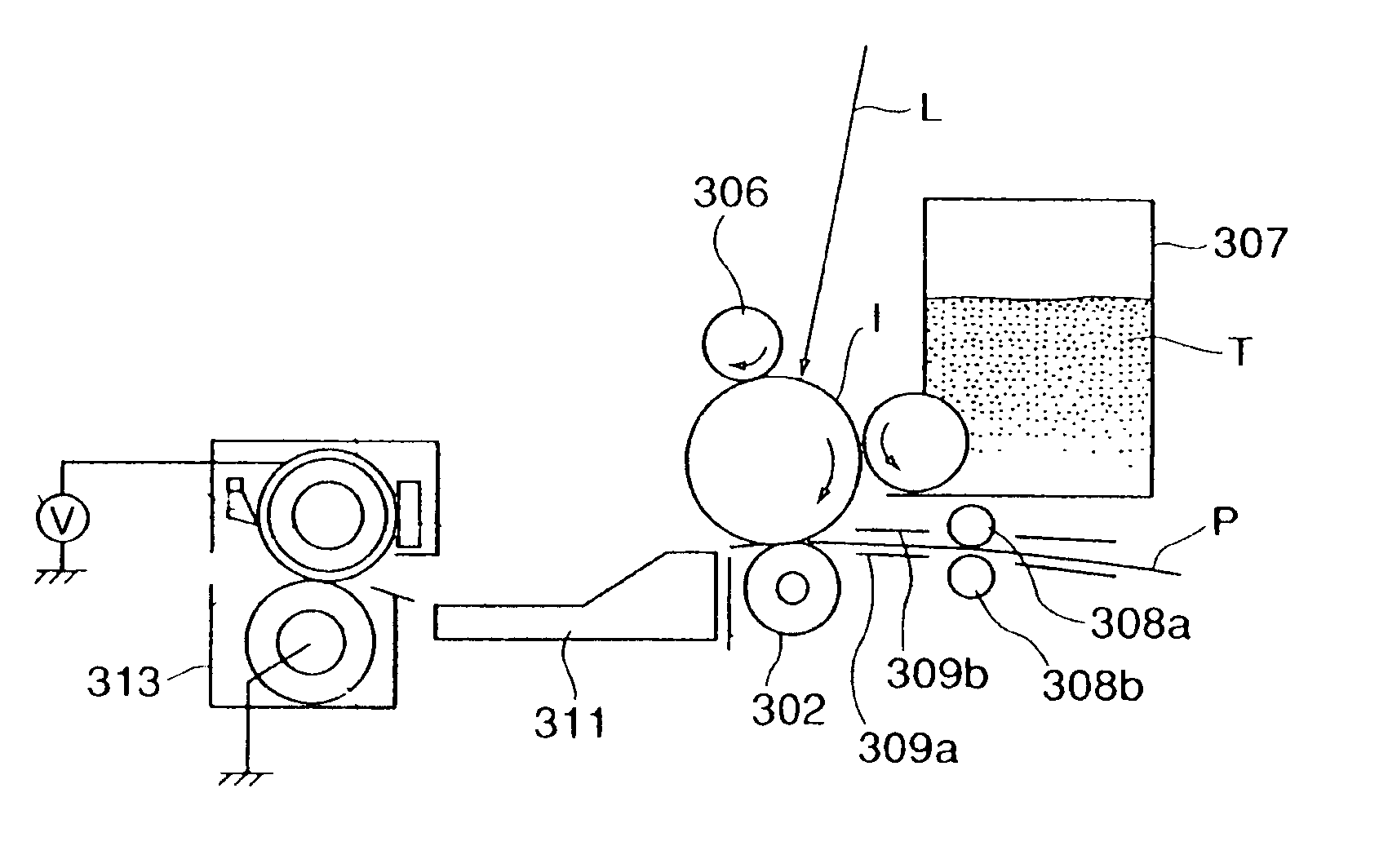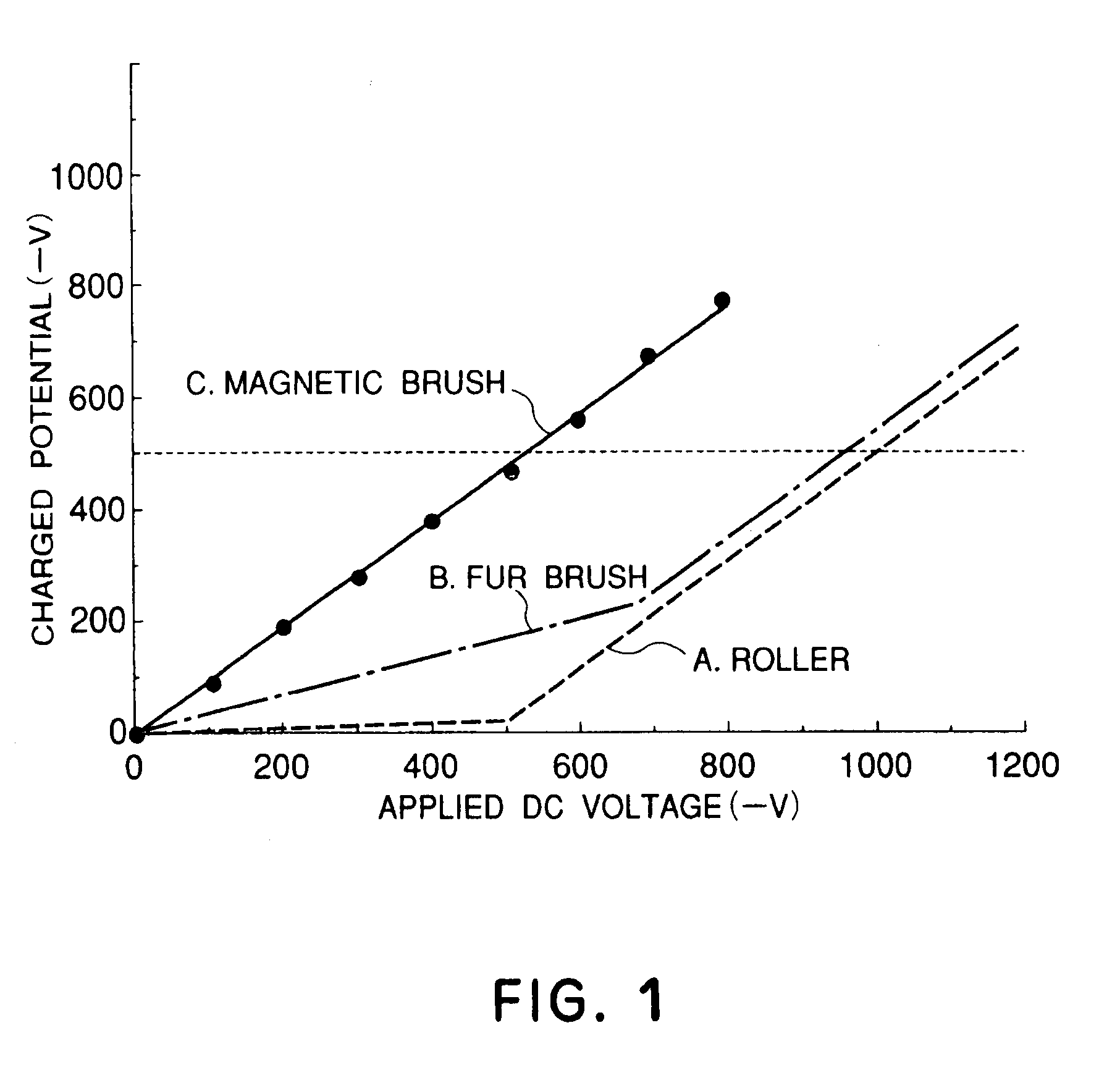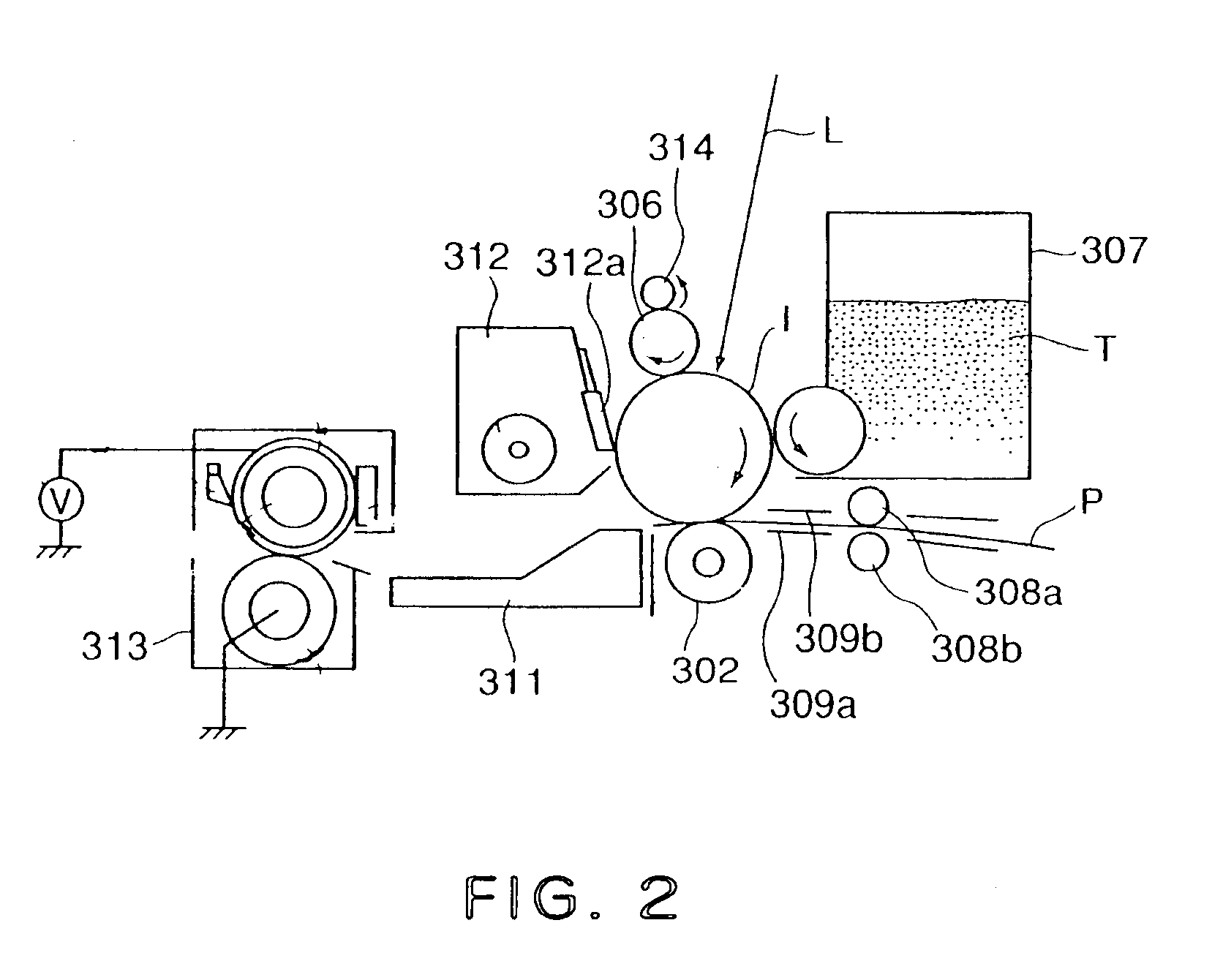The developing method using an electroconductive magnetic toner is an excellent method capable of obviating problems involved in a conventional two-component developing method but, on the other hand, involves a difficulty in electrostatic transfer of the developed toner image from the image-bearing member to a recording material, such as plain paper because of the electroconductivity of the toner.
This method however involves an inherently slow developing speed and an insufficient developed image density.
This method involves a difficulty that insufficient triboelectric charge or charging failure is liable to occur due to a relatively low frequency of contact between the magnetic toner particles and the friction member and also due to exposure of the magnetic material at the magnetic toner particle surface.
However, such insulating magnetic toner particles are accompanied with a substantial amount of fine magnetic powder and also a portion of the magnetic powder exposed at the magnetic toner particle surface, which are liable to affect the flowability and triboelectric chargeability of the magnetic toner.
More specifically, due to the exposure at the magnetic toner particle surface of fine magnetic powder having a lower resistivity than a resin constituting the magnetic toner particles, the magnetic toner particles are liable to cause a lowering in chargeability, a lowering in flowability and separation of the magnetic powder due to friction or rubbing between individual magnetic toner particles and between the toner particles and a regulation member during a long term of uses, thus being liable to cause an image density lowering and image density irregularity called sleeve ghost.
These treatments provide a somewhat improved dispersibility in the toner but are accompanied with a problem that it is difficult to uniformly hydrophobize magnetic powder surfaces, so that it is difficult to obviate the coalescence of magnetic powder particles and the occurrence of untreated magnetic powder particles, thus leaving a room for further improvement in dispersibility of magnetic powder in the toner particles.
Further, as a result of such a surface treatment, the exposure of magnetic iron oxide powder from the magnetic toner particle surfaces can be suppressed to some extent, but it is difficult to uniformly hydrophobize the magnetic iron oxide powder surface, so that the occurrence of coalescent magnetic iron oxide powder particles and yet-unhydrophobized magnetic iron oxide powder particles is inevitable, and the suppression of the surface exposure of magnetic iron oxide powder becomes insufficient.
However, the magnetic iron oxide powder inherently has a relatively low surface activity so that coalescence of magnetic powder particles and insufficient hydrophobization are inevitable, thus leaving the necessity of further improvement for use in an image forming method operated under a severe condition as by inclusion of a contact charging step discussed hereinafter.
The use of a larger amount of hydrophobizing agent or a hydrophobizing agent having a higher viscosity provides a higher hydrophobicity of the treated magnetic powder but also results in increased coalescence of magnetic powder particles, thus resulting in a rather inferior dispersibility.
As a result, a toner produced by using such a treated magnetic iron oxide powder is caused to have non-uniform triboelectric chargeability, leading to inferior fog prevention and transferability.
As described above, a conventional polymerization toner using such a surface-treated magnetic powder has not succeeded in a good combination of hydrophobicity and dispersibility, and it is difficult to stably obtain high-definition images if such a polymerization toner is used in an image forming method including a contact charging step as described hereinafter.
However, based on the direct injection charging mechanism, the charging performance is affected by the contactivity of the contact charging member onto the member-to-be-charged.
Accordingly, even if the direct injection charging is intended, the lowering in charging performance, and charging irregularities due to insufficient contact, contact irregularity due to the roller shape and attachment onto the member-to-be-charged, are liable to be caused.
In the DC charging scheme, however, it has been difficult to charge the photosensitive member to a desired potential, since the resistivity of the contact charging member is liable to change in response to a change in environmental condition, and because of a change in Vth due to a surface layer thickness change caused by abrasion of the photosensitive member.
Further, in the AC-charging scheme for uniform charging, ozone generation is liable to be promoted, a vibration noise (AC charging noise) between the contact charging member and the photosensitive member due to AC voltage electric field is liable to caused, and the photosensitive member surface is liable to be deteriorated due to the discharge, thus posing a new problem.
100 / mm2 can be relatively easily obtained, but even at such a high fiber density, the contact characteristic is insufficient for realizing sufficiently uniform charging according to the direct injection charging.
The magnetic brush charging scheme is however accompanied with difficulties that the device structure is liable to be complicated, and the magnetic particles constituting the magnetic brush are liable to be liberated from the magnetic brush to be attached to the photosensitive member.
If an insulating toner is attached to or mixed into the contact charging member, the charging performance of the charging member is liable to be lowered.
On the other hand, in the charging scheme wherein the direct injection charging mechanism is predominant, the lowering in charging performance is caused as a lowering in chargeability of the member-to-be-charged due to a lowering in opportunity of contact between the contact charging member surface and the member-to-be-charged due to the attachment or mixing of the transfer residual toner particles into the contact charging member.
The lowering in uniform chargeability of the photosensitive member (member-to-be-charged) results in a lowering in contrast and uniformity of latent image after imagewise exposure, and a lowering in image density and increased fog in the resultant images.
However, if the transfer residual toner particles are attached to or mixed to the contact charging member in an amount exceeding the toner charge polarity-controlling capacity of the contact charging member, the charging polarity of the transfer residual toner particles cannot be uniformized so that it becomes difficult to recover the toner particles in the developing step.
Further, even if the transfer residual toner particles are recovered by a mechanical force of rubbing, they adversely affect the triboelectric chargeability of the toner on the toner-carrying member if the charge of the recovered transfer residual toner particles has not been uniformized.
As a result, in the case of a continuous use of the apparatus for a long period, the defect of image flow due to the ozone products is liable to occur.
Further, in case where the above organization is adopted in the cleanerless image forming apparatus, the attachment of the powder onto the charging member is obstructed by mixing with transfer-residual toner particles, thus reducing the uniform charging effect.
The contact charging or proximity charging scheme used in the proposal is one relying on the discharge charging mechanism and not based on the direct injection charging mechanism so that the above problem accompanying the discharge mechanism accrues.
Further, in case where the above organization is applied to a cleanerless image forming apparatus, larger amounts of electroconductive particles and toner particles are caused to pass through the charging step and have to be recovered in the developing step.
Further, in a case where a contact charging scheme relying on the direct injection charging scheme is adopted, the electroconductive fine particles are not supplied in a sufficient quantity to the contact charging member, so that the charging failure is liable to occur due to the influence of the transfer residual toner particles.
Further, in the proximity charging scheme, it is difficult to uniformly charge the photosensitive member in the presence of large amounts of electroconductive fine particles and transfer residual toner particles, thus failing to achieve the effect of removing the pattern of transfer residual toner particles.
As a result, the transfer residual toner particles interrupt the imagewise exposure pattern light to cause a toner particle pattern ghost.
Further, in the case of instantaneous power failure or paper clogging during image formation, the interior of the image forming apparatus can be remarkably soiled by the developer.
This image forming method however relies on a contact charging scheme based on the discharge charging scheme and not on the direct injection charging scheme, so that the system is not free from the above-mentioned problems involved in the discharge charging mechanism.
Further, these proposals may be effective for suppressing the charging performance of the contact charging member due to transfer residual toner particles but cannot be expected to positively enhance the charging performance.
Such an image forming apparatus may exhibit a good development and simultaneous cleaning performance and remarkably reduce the waste toner amount, but liable to result in an increased production cost and a difficulty against the size reduction.
Including the OPC photosensitive member, currently commercially available photosensitive members for use in image forming apparatus are not necessarily satisfactory in all respects of sensitivity, durability, image quality and anti-pollution characteristic, and the weak points of respective photosensitive members have been compensated by toner designing or process designing to provide commercially acceptable image forming apparatus on the market.
 Login to View More
Login to View More  Login to View More
Login to View More 


